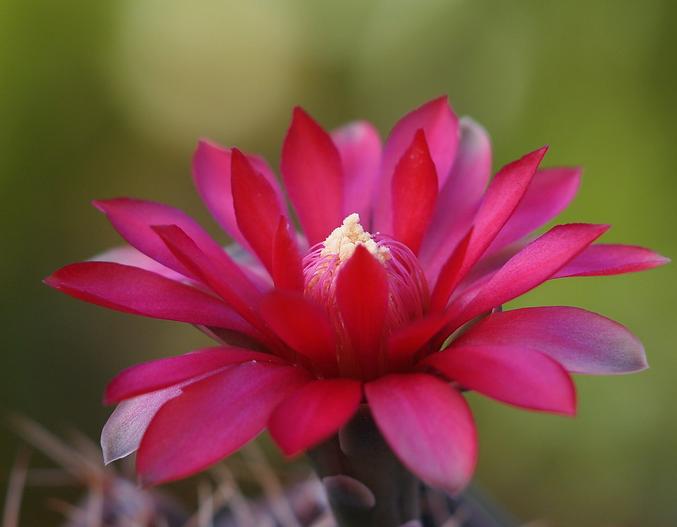Dwarf Chin Cactus
(Gymnocalycium baldianum)
Dwarf Chin Cactus (Gymnocalycium baldianum)
/
/

Dornenwolf
CC BY 2.0
Image By:
Dornenwolf
Recorded By:
Copyright:
CC BY 2.0
Copyright Notice:
Photo by: Dornenwolf | License Type: CC BY 2.0 | License URL: https://creativecommons.org/licenses/by/2.0/ | Uploader: Dornenwolf | Publisher: Flickr





















Estimated Native Range
Summary
Gymnocalycium baldianum, commonly known as Dwarf Chin Cactus, is an evergreen succulent originating from the mountainous regions of northwestern Argentina. This cactus typically forms a globose, spherical to slightly flattened shape, reaching up to 8 cm in diameter, with a dark green or sometimes brown coloration. The striking funnel-shaped flowers, which can be red, pink, or orange, bloom near the apex of the plant and reach a diameter of up to 6 cm. Flowering occurs in late spring to early summer and adds a vibrant splash of color to the plant’s appearance.
The Dwarf Chin Cactus is valued for its ease of cultivation and the bright, showy flowers that contrast beautifully against its dark green body. It is well-suited for rock gardens, container planting, and as a houseplant. It requires well-drained soil and thrives in full sun to part shade. During the summer, watering should be thorough, allowing the soil to dry out completely between waterings. A monthly application of cactus fertilizer can promote healthy growth. In winter, the plant should be kept dry, and while it can tolerate temperatures as low as −10 °C (14 °F), it is best to avoid frost. Gymnocalycium baldianum has earned the Royal Horticultural Society’s Award of Garden Merit, indicating its exceptional qualities for garden use. Potential problems include overwatering, which can lead to root rot, and pest infestations such as scale insects.CC BY-SA 4.0
The Dwarf Chin Cactus is valued for its ease of cultivation and the bright, showy flowers that contrast beautifully against its dark green body. It is well-suited for rock gardens, container planting, and as a houseplant. It requires well-drained soil and thrives in full sun to part shade. During the summer, watering should be thorough, allowing the soil to dry out completely between waterings. A monthly application of cactus fertilizer can promote healthy growth. In winter, the plant should be kept dry, and while it can tolerate temperatures as low as −10 °C (14 °F), it is best to avoid frost. Gymnocalycium baldianum has earned the Royal Horticultural Society’s Award of Garden Merit, indicating its exceptional qualities for garden use. Potential problems include overwatering, which can lead to root rot, and pest infestations such as scale insects.CC BY-SA 4.0
Plant Description
- Plant Type: Succulent
- Height: 0.1-0.2 feet
- Width: 2-3 feet
- Growth Rate: Slow
- Flower Color: Orange, Pink, Purple, Red, White
- Flowering Season: Summer
- Leaf Retention: Evergreen
Growth Requirements
- Sun: Full Sun, Part Shade
- Water: Very Low, Low
- Drainage: Fast
Common Uses
Drought Tolerant, Low Maintenance, Rock Garden, Street Planting
Natural Habitat
Originates from the mountainous regions of northwestern Argentina
Other Names
Common Names: Spider-Cactus
Scientific Names: , Gymnocalycium baldianum, Gymnocalycium schreiteri, Gymnocalycium sanguiniflorum, Gymnocalycium raineri, Gymnocalycium baldianum subsp. venturianum, Gymnocalycium baldianum var. albiflorum, Echinocactus baldianus, Echinocactus sanguiniflorus, Gymnocalycium baldianum subsp. sanguiniflorum
GBIF Accepted Name: Gymnocalycium baldianum (Speg.) Speg.